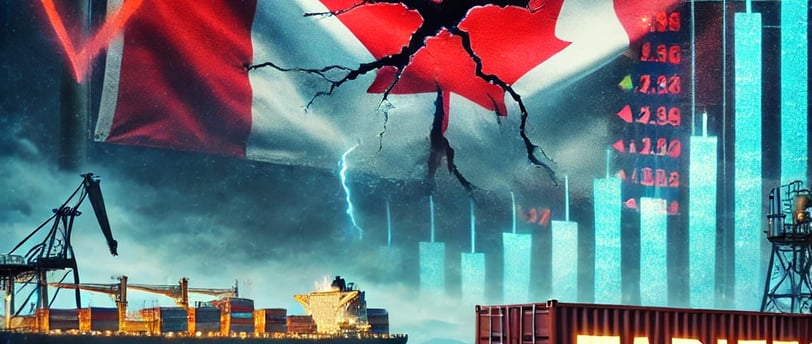Canada’s Reckoning: How Short-Sighted Policies Led to Economic Weakness
Canada's economic missteps have led to a harsh wake-up call. With U.S. tariffs exposing our trade dependence, missed energy opportunities, and reckless fiscal policies, it's time to rethink our future. Read the full breakdown and what it means for investors.
ECONOMIC POLICY & TRADEMARKET & INVESTMENT INSIGHTSENERGY & NATURAL RESOURCESGOVERNMENT & FISCAL RESPONSIBILITYGEOPOLITICS & GLOBAL RELATIONS


Canada’s Reckoning: How Short-Sighted Policies Led to Economic Weakness
For nearly a decade, Canada has prioritized ideological governance over economic pragmatism, and now, the country is reaping the consequences. The recent imposition of 25% tariffs by the United States on Canadian goods, along with a 10% levy on energy exports, has thrown Canada into an economic storm that was entirely predictable and avoidable. This moment is not just about trade—it’s about Canada’s self-inflicted economic fragility after years of ignoring fiscal discipline, energy independence, and geopolitical strategy.
The False Promises of Canada’s Economic Leadership
For years, Canadians were told that debt didn’t matter. That “the budget will balance itself” was more than just a soundbite—it became the foundational philosophy of economic policy. Under Prime Minister Justin Trudeau’s leadership, Canada’s national debt has ballooned to record highs, and instead of addressing it through economic growth or resource expansion, the government doubled down on taxation. Rather than tackling inefficiencies, they taxed productivity.
This fiscal recklessness was compounded by foreign policy spending on ideological pursuits, sending billions in aid overseas while domestic industries struggled. Canada championed progressive social initiatives at home and abroad while failing to build an economic foundation that could withstand global shocks. The result? Canadians are now among the most heavily taxed populations in the developed world, facing increasing costs on everything from groceries to real estate.
Now, as the U.S. moves forward with tariffs, Canada finds itself financially cornered, with no real economic levers left to pull other than retaliation—which only escalates the damage. This is the price of prioritizing optics over outcomes.
Trade Dependence: A Nation Caught Off Guard
The tariffs imposed by President Trump are not the cause of Canada’s economic instability—they are simply exposing it. The real issue lies in Canada’s dangerous over-reliance on the United States as its primary trading partner. Roughly 75% of all Canadian exports go to the U.S., meaning any disruption to this trade relationship is a catastrophe.
The U.S., for its part, is pursuing a strategy of economic self-reliance and selective partnerships—and Canada is no longer at the top of the priority list. When President Trump re-entered office, he made it clear that he intended to “drain the swamp” and remove barriers to domestic economic strength. This includes restructuring trade agreements to favor the U.S. and punishing countries that fail to stand on their own.
Canada should have seen this coming and diversified its trade agreements years ago. Instead, we ignored opportunities to strengthen our position in global markets, leaving us vulnerable to this economic chokehold. The failure to proactively negotiate alternative trading partnerships with nations like Japan, Germany, and India has left Canada scrambling to find solutions only after the damage has already been done.
The Energy Sector: A Story of Missed Opportunities
Nothing highlights Canada’s failure to plan for economic resilience more than our energy industry’s neglect. Canada possesses some of the richest natural resources in the world, yet has spent the past decade kneecapping its own energy sector in an effort to meet arbitrary environmental targets that have done little to meaningfully impact global carbon emissions.
Instead of expanding liquefied natural gas (LNG) exports to markets that needed it—such as Japan and Germany—Canada delayed and hesitated, leaving the door wide open for the United States to swoop in and secure those deals. The U.S. managed to strike a historic energy agreement with Japan in less than six months, while Canada—despite having both the infrastructure and the resources—failed to act.
If Canada had seized these opportunities when they arose, it would have been able to counterbalance U.S. tariffs with expanded exports to other nations. Instead, our leaders were too focused on domestic political theatrics to engage in strategic economic planning.
Now, our dependence on the U.S. as our largest buyer of natural gas and oil has backfired—and we have no backup plan.
The Real Estate Crisis: The Hidden Economic Strain
Beyond trade and energy, another self-inflicted wound is Canada’s housing market crisis, which has been artificially inflated due to unchecked foreign investment and mass immigration policies. Vancouver and Toronto, once centers of Canadian culture and opportunity, are now among the most unaffordable cities in the world—not for foreign buyers, but for Canadians themselves.
Instead of ensuring that Canadian citizens had first access to homeownership, the government prioritized foreign capital inflows from countries like China. These investments have driven up property values to absurd levels, creating a housing bubble that is unsustainable.
The result? Middle-class Canadians have been priced out of their own cities, forced to either rent indefinitely or relocate entirely. Meanwhile, the economic imbalance between regions continues to grow, as certain industries fail to provide wages that align with the soaring cost of living.
The U.S. has taken notice. One of the unspoken reasons behind these tariffs is the increasing perception that Canada is no longer the same country it once was. The population shift and change in economic priorities have led to a loss of trust. This isn’t about race or diversity—it’s about the erosion of economic identity. When the Canadian government prioritized inclusivity over economic sustainability, it made the wrong bet.
Where Do We Go From Here?
Canada is now in damage control mode, and it’s time for citizens to understand the reality of the situation. There are consequences to voting for policies that sound good on paper but have no economic foundation. Gender politics, climate targets, and global virtue signaling are luxuries of a strong economy—not tools for building one.
But despite all of this, opportunity still exists for those who have been financially responsible. Market downturns always bring buying opportunities, and smart investors can capitalize on undervalued stocks, real estate corrections, and shifts in the global economy. Fortunes are made in economic downturns, not booms. This moment, while challenging, presents a rare window for those who are ready to act.
Additionally, Canada must immediately begin working toward true economic independence:
Diversifying trade agreements: We can no longer rely solely on the U.S. as our primary buyer. Trade deals with Germany, India, and Japan should be aggressively pursued.
Restoring energy dominance: The world needs what Canada has. Instead of restricting our own industries, we should actively expand LNG exports to capitalize on demand.
Fixing the housing crisis: Foreign speculation must be severely restricted, and immigration policies need to be realigned with economic capacity.
Cutting government waste: The country cannot afford to keep spending billions on ideological programs while the middle class is suffocating.
Final Thoughts
This trade war is not just about tariffs—it’s about Canada waking up to reality. We have allowed weak policies, performative governance, and economic complacency to bring us to this moment.
The good news? This is a wake-up call. A moment where we redefine our priorities and begin to build an economy that is strong, independent, and resilient.
For those paying attention, this is a time to prepare, invest, and strategize. And for those who aren’t—well, they’ll be left behind.
Stay informed. Stay ahead. Subscribe now to CryptoInsightBlog to keep up with the real economic story. And as a thank you, I’ll be doing a giveaway at 1,000 subscribers—cash, BTC, or crypto memorabilia. Be part of the movement.


